Mako: Jaws of Death, The Naked Zoo, Whiskey Mountain (1971, 1976, 1978)
Directed by: William Grefe
Written by: Nicholas E. Spanos, Ray Preston, Robert W. Morgan, William Grefe
Starring: Christopher George, Richard Jaeckel, Rita Hayworth
Following on from Bat’s review earlier today [which you can check out here] of the first two discs of Arrow’s ‘He Came From The Swamp: The William Grefe Collection’, Doc reviews the final two discs!
DISC 3
THE NAKED ZOO [1971]
Terry is a struggling writer living in the counter culture scene of Miami. He’s able to earn enough cash to keep him going by offering his sexual services to older women. One of his clients is Mrs. Golden, whose much older husband, Harry, is in a wheelchair. But Terry prefers his many younger lovers. Then Harry has a fatal accident and suddenly Terry doesn’t want to be around Mrs. Golden any more….
I had heard of The Naked Zoo as being one of the final films featuring the 1940’s ‘love goddess’ Rita Hayworth who was one of the first old time glamour girls who really took my fancy when I was young, so that was my main interest in seeing it. I had also heard that it was terrible. I wouldn’t go that far, but it’s certainly very odd, feeling like it was shot and assembled in no particular fashion. I like counter-culture stuff, so the fact that much of this movie, originally called The Grove which was the name of a hippie enclave in Miami, consists of a lot of footage of oddly dressed people getting high and getting their groove on didn’t bother me, though it may bother others, much like that endless party scene in Midnight Cowboy which tends to stop the otherwise excellent film dead for many people. There’s a very lengthy sequence when Terry is too bothered by things to continue servicing one of his clients, so he takes her back to his house. After a weird bit where she reveals herself to be racist and Terry’s favourite bed partner the African-American Nadine pretends to be his servant, he gives her some LSD and she has a very interesting time indeed, some of it good, some of it bad. Grefe and his co-writer Ray Preston seem torn between sympathy for this poor lady who wants to be hip with the kids, and somewhat cruel mockery of her, Grefe’s attempts at creating psychedelic visuals don’t really go beyond kaleidoscopic split screen, and in terms of plot it’s all totally unnecessary, but it has a strong documentary feel to it. In fact the whole thing is a solid snapshot of the time and the environment; the clothes, the drugs, the interior design, even if it opens with a situation as old as the hills, a man and a woman being caught in bed by the woman’s husband, after which the titles occur over him fleeing topless.
I mentioned the word “plot” earlier but that isn’t really an appropriate term. There is a storyline involving Hayworth’s character Mrs. Golden, her husband and Terry, its highpoint probably being a very odd scene when hubby catches his wife and Terry together and invites him to dinner where Terry babbles about screenwriter with lines like, “if you don’t have the Aristophelean flame underneath the very basic allegorical line, then you lack the classical structure”. Friendliness doesn’t last long, and Terry soon begins to wonder if Mrs. Golden isn’t the nice lady that she seems to be. The 53-year old Hayworth gives a solid performance though her alcoholism had sadly faded her once-fantastic looks some time before, and there’s a lively action scene set inside the lounge where strange angles and kinetic camerawork are put to good work. However, these scenes only make up a small amount of the running time, and it’s doubtful that Hayworth met any of the rest of the cast since she doesn’t interact with any of them onscreen. The majority of the film follows Terry elsewhere as he beds various women, drinks, and gets stoned. He’s not very likable the way he treats them like pieces of meat and even kicks one of them while she’s kissing his toes when he flies into a rage, though they still seem to be at his beck and call. He also does some strange things, like in the film’s highlight or lowlight when he sets his sights on Nadine at a “happening” and decides to cause a distraction so he can abscond with her. This distraction consists of pretending to faint because he’s really cold even though the room is warm, demanding that a fire is started, and smashing a chair to start it while many of the others present follow suit.
But then most people in this film behave very oddly [even when they haven’t consumed anything] and say odd things to each other. “You know baby, we could miscegenate, you and I, and be the first in the neighbourhood, miscegenate the neighbourhood” is a particular highlight or lowlight. Terry even seems aware of this as he says at one point, “there are sure a lot of weird people around here”, though he can’t really talk. The overall feeling of incoherence can possibly be said to suit the environment, and I wonder if some kind of point is being made about Terry’s unpleasantness yet inexplicable popularity [ hell, he doesn’t even dress in a cool fashion, he’s just clad in a boring suit except for one brief scene], though I couldn’t work out what it was. A sex scene being intercut with a naked statue of a man with a disapproving look on his face is about the closest the thing gets to wit, though I do sense a certain wry attitude to all this counter culture stuff, while Joe Sherman’s music score sometimes gives us a vocal version of its main theme which contains lyrics like, “you know you made the animal in me bust this rusted chain”. This is a very scrappy film which looks like it was cobbled together just to cash-in on a major current movement and give a job to a once-in-demand Hollywood star, and might be something of an endurance test if you don’t find the sociological side of things interesting like I did.
Rating: 









Introduction by William Grefe [2 mins]
The director provides a brief introduction, talking of how the investors wanted a name so he got Hayworth, and about the re-cut.
William Grefé’s original Director’s Cut of ‘The Naked Zoo’
The negative for Naked Zoo was obviously in pretty bad shape, because there are sections with scratches and even big splices, what sounds like telecine noise, and faded colour; there’s one bit where I couldn’t tell if the film was supposed to be in black and white or colour. However, the good portions do look pretty good, with vibrant colours and decent detail. Newcomers may find all this jarring, though fans should be happy that they were able to even partly restore the film.
Alternate Barry Mahon re-release cut of ‘The Naked Zoo’
I skimmed through this version which is six minutes shorter. Some portions of dialogue and an entire scene of Terry in the Golden household were removed, while the inserted footage consists of a topless woman pleasuring herself and a band playing during a party where people are clearly dancing to something else. It sticks out like a sore thumb. A new title sequence was put together too. It’s mall wonder that Grefe hated this version. It’s of a more consistently good picture quality though.
Audio Commentary on the Director’s Cut by William Grefe
I hoped that Grefe would go into the construction of the screenplay, his decisions, and what he was aiming for, even mean. He doesn’t do that at all. However, in between pointing out cast members, he does tell a lot of stories concerning the production and by extension the world of ’70s low budget filmmaking, including a cracker of a tale about a film crew who got arrested in Mexico when one of them hit a policeman. The producer rang the town’s mayor, who flipped a switch that turned off all electricity, then told the police that the power was supplied by a town in America which would withhold it from them if the people weren’t released! We also hear of how the lack of one contract led to cast and crew all supplying something for a set, how the Miami authorities wouldn’t let them shoot such a drug-filled picture there so they shot a few exteriors on the sly then did the rest in a studio, and lots about Hayworth. Her being used to lots of takes, Grefe would begin by shooting many, then lessening the number each day until she was happy with just one or two. Overall a really good track, if a tad unsatisfying.
Stills Gallery [6 mins]
MAKO: JAWS OF DEATH [1976]
In the Philippines, Sonny Stein was saved from bandits by sharks and given a medallion by a native tribe that protects him from the creatures. Now he lives on a small island in Florida, working as a rubbish collector. Oceanographer Whitney tells him that if he loans him his pet pregnant female shark, the data will help stop a bounty the government wants to put on sharks. Underwater artist Karen and her sleazy bar owner husband Barney want another one of his sharks for her act. And Whitney’s two hunter pals Charlie and Pete are killing lots of sharks. But Sonny is very protective of his sharks….
It may be a fantastic movie, but it was Jaws that really cemented the general opinion of sharks as deadly, scary predators who should be hunted down, leading to drastic depleting of the shark population. Therefore it’s a relief to find a movie featuring the animals where they’re more the victims; yes, there are a few shark kills replete with copious red colouring the blue water, but it’s some humans that are the real villains and sharks are just another type of animal for them to exploit. I’d heard of Mako: Jaws Of Death as one of the many Jaws rip-offs that were made in the wake of that film, but one of the featurettes tells us that Grefe and Robert W. Morgan actually wrote the script some time before Steven Spielberg’s classic but couldn’t get it made until its release. I certainly believe this, because it actually isn’t much like Jaws at all; in fact it plays more like a variation of Willard. One thing I really enjoyed was that people including even star Richard Jaeckel are clearly swimming right by and in front of sharks just like the opening onscreen text claims; you couldn’t fake that shit in 1976. One thing I didn’t really enjoy was that the sharks don’t appear to be in good health and I got the feeling that some may have been killed just for the purposes of the movie.
Though it’s immediately quite clear that, despite the title, we’re watching Tiger sharks not Mako ones [that’ll teach me for knowing my sharks] despite the title, we do open in quite a strong fashion, almost like a slasher movie, with two people out on a boat trying to catch a shark. They seem to succeed, but then someone cuts it loose, then boards the boat still keeping his diving mask on, and, without speaking a word, almost slays them with hook and harpoon before tossing them into the sea to be finished off by sharks. We can already tell that it’s Jaeckel under the helmet, and it soon becomes apparent that this is one of his more interesting roles. Sonny is a loner who just wants his fishy friends to be left in peace. Despite being a very physically strong person who is out to protect sharks to the point that he’s happy to kill, he’s also childlike, naive and trusting to the point of being major flaws; indeed it’s all these qualities that are used by others and lead to his undoing. He seems to be able to communicate with sharks through telekinesis, though these chats are handled in a way as to make Sonny just delusional. Jaeckel is really good though, which is perhaps just as well considering that, after the beginning, it’s just lots and lots of not particularly good chat for ages afterwards. There’s an especially lengthy segment where Sonny saves Karen from being raped and takes her to his island; he was spellbound by her earlier when she performed underwater but doesn’t seem much interested in her now. Karen’s a nasty sort; happy to be exploited by her husband and paying Sonny back for rescuing her by getting him to lend her one of his sharks. We spend a fair bit of time with Karen but never feel that we get to know her at all.
Of course what the story is obviously doing is setting up unpleasant characters for us to enjoy their demise. Sonny isn’t told the truth by the bar owners, scientists and hunters [one of them played by Harold Sakata aka Oddjob] he encounters, and we care enough to feel his pain when he comes upon one particularly devastating revelation. I’m not sure that the drive-in audience would have necessarily taken kindly to all the preaching about animal protection, though as it’s something I feel quite strongly about I had no problem with it. Grefe, possibly going for a more family audience [though it’s hardly Flipper], seems happy to hold back on graphic gore and the film doesn’t really suffer from this, though a few more scenes of vengeance both human and shark wouldn’t have gone amiss. The underwater footage is very well filmed with effective camera angles; above ground things aren’t always as good though there’s a short but rather splendid outdoor chase set amid a very strong wind. The music score by William Loose and Paul Ruhland is often being relied on create suspense, including in some moments where you wouldn’t think it would be needed. With a bit more work on the script Mako: Jaws Of Death could have been genuinely compelling; as it is, it’s certainly interesting enough to take you past its dead spots, and openly wears its heart on its sleeve which is admirably unusual for an exploitation picture of the time.
Rating: 









Introduction by William Grefe [4 mins]
Grefe tells of how he wrote the script before Jaws but nobody was interested in it, how he directed the shark footage for Live And Let Die, and how mishaps on set led to the crew having no boat, no camera and no star, all on the first day of shooting.
Mako: Jaws Of Death
This looks rather better than The Naked Zoo. There are quite a few lines running down the screen at a few points, but otherwise it’s fine; apparently on DVD it looked really dark in places, probably mainly the nighttime scenes which just seemed rather natural in appearance on Blu-ray. The audio is spotty though, with some dialogue hard to hear.
Audio commentary with William Grefe
Even if it opens with what we heard on Grefe’s introduction [these introductions are pointless really though I suppose it’s nice to see the man himself], this is a tremendously information-packed track. Of course I’d still like to know more about the screenplay, but the non-stop chat tells us where every scene was filmed and gives us loads of good stories; Jaeckel only flubbed one like, a nameless “individual” tried to disrupt filmmaking, and how John Davis Chandler [Pete] swapped with Harold Sakata so he didn’t have to interact with sharks, having been told a story by another actor where Grefe lied to him about not being near live snakes. Grefe points out some day for night footage which even I failed to notice, is rightly proud of never going over budget or time, and tells us when a toothless shark is attacking a stuntwoman for real on screen. I get the sense that he’s not telling the entire truth about the use of sharks, but Grefe is still great to listen to, his throaty, elderly voice being actually rather relaxing. Funny when he says that low budget filmmakers would often make up names so people didn’t find out that the crew was so small.
Beyond The Movie: That’s Sharksploitation [7 mins]
This and the following three special features are not listed at the time of writing; obviously Arrow produced them late in the day, showing that the company still go all out to please fans of the films that they release. Michael Gingold takes us through a potted history of shark movies after mentioning the ecologically themed ‘revenge of nature’ cycle, telling us that the first one after Jaws was a TV movie called Shark Kill, that the animals suddenly started turning up a lot in TV shows and cartoons, and reminds us of when Universal sued the makers of Great White and got it removed from cinemas.
The Aquamaid Speaks [11 mins]
This an audio interview with Jennifer Bishop who played Karen in Mako: Jaws Of Death. Ed Tucker asks her all the right questions and after some early hesitation she seems happy to chat about the film. She says that she enjoyed the filming, provided her own wardrobe, and never saw any sharks despite her character often being in close proximity to them.
Sharks, Stalkers and Sasquatch [11 mins]
This time Ed Tucker interviews a very relaxed-sounding Robert Morgan, the screenwriter, for another audio chat. We learn that Sharkenstein was the original title, that he met Grefe will searching for Bigfoot, and that Harold Sakata was nearly strangled to death on Impulse, another Grefe effort; we see it because it was left in the film!
Super 8 Digest Version [15:06]
In the days before video, the only way to own a movie was in heavily condensed Super 8 form. I don’t think I’ve ever seen one, so I was quite intrigued to watch this. A few scenes from the film are cut together, not always quite in order, to tell some of its story. It’s quite well done and looks better than you might expect too.
Theatrical Trailer [1 min]
Original Promo [10 mins]
CBS Promo [30 seconds]
Behind the Scenes Segment [2 mins]
Still Gallery [8 mins]
DISC 4
WHISKEY MOUNTAIN [1978]
Four motorcyclists – tough Bill, easygoing Dan, and their wives – nervous Diana and feisty Jamie – set off for the wilderness to find a stash of guns left on Whiskey Mountain by Jamie’s great grandfather during the American Civil War. Legend has it that 25 barrels of whiskey are also hidden there. However, the mountain is right by a marijuana farm, and the farmers don’t take kindly to trespassers….
Grefe sure seems to like motorbikes. Probably around half of the time in this movie is dedicated to shots of the four main characters riding through countryside on them for long periods. When one of the bikes is lost during a river crossing, the camera tracks its demise at length and finally zooms in on it before eventually cutting away. Even one of the bad guys gets hold of a bike, and, after being told what to do, rides off and we stay with him for some time. So I guess a motorbike enthusiast would probably love Whiskey Mountain – and even I was able to thrill at a daring cycle jump over a broken bridge with no edits in the filming so we know it was totally done for real. Generally though, the rest of us are probably unlikely to love it, though I did find it to be rather better than The Naked Zoo. Even though Grefe fails to mention this, it partly comes across as his version of Deliverance, and was even shot in some of the same North Carolina locations near a cabin owned by Grefe and features one of its bit players in another tiny part. By far the best-looking [ignoring print damage] of the three Grefe films that I’ve reviewed, it has very fine outdoor cinematography by Julio C. Chavez and a cast which is a solid roundup of ‘B’ faces of the period, with Christopher George, Roberta Collins, William Kerwin and familiar Grefe face John Davis Chandler all doing good work, though it’s an insanely giggling Robert Leslie who almost steals the show as a crazy old man who doesn’t seem to be good or bad, just is.
We begin with some motor-cross racing [what else?] and a rather neat scene where one rider has an accident and causes another rider to also cock things up, leading to an argument which we we can’t hear what they’re saying because the race is still going on around them. Then Bill and Jamie go to buy some guns in a shop and blurt out where they’re going where they’re going to which is pretty stupid if you ask me. Our foursome then set off, but when Bill, Dan and Diana go into a shop/bar where, of course, they’re stared at by the locals, Diana is pestered by three guys, already telling us that we’re in ‘hicksploitation’ land, where country yokels are threatening and stupid, though the ones here aren’t as ugly as some. Virtually everyone around is sinister; we don’t even trust the local Sheriff. The group travels – and travels – and travels. This wouldn’t too bad if we had well written characters to spend time with, but instead it’s a bit tedious despite the good photography including a fine shot leading to a solid jump scare where we pull back from the group at night and suddenly a dark figure appears out of the right side of the frame. Grefe is obviously a film-maker who likes to take his time, likes us to hang out with the people in his films, but the writing abilities of him and his script collaborators hamper this and we end up just waiting for the exciting bits. Some incidents provide some trouble until we get a rape sequence where the camera remains fixated on a table upon which photographs of the incident – shot by one of the villains – appear and are developed immediately. It’s a rather neat device, and actually makes the scene more disturbing rather than less, though grindhouse patrons may have felt let down by not being shown the action properly. What bothered me was the bit after, where the husbands, instead of trying to rescue their wives, go off into town to tell the Sheriff.
Indeed Grefe, on the evidence of these three films, is unlike many of his contemporaries in that he’s not that keen on showing lots of nasty stuff, or maybe he just finds it unnecessary. Take a knife slashing by Bill of one of the villains; you’d expect to see at least a bit of blood, but we don’t see any. The final third of Whiskey Mountain does still deliver a fair amount of action and even some slow motion that makes me wonder if Grefe was thinking of Sam Peckinpah, but mishandles some important moments, like the death of the lead bad guy; it’s shown at a distance so it’s hard to actually tell if it’s him or not. The hidden guns are totally forgotten about – I was expecting them to be used in the climax – though of course not fulfilling expectations can be a good thing. At least the ending is in keeping with the way motorbike pictures of the period tended to end – negatively, even though the freeze frame used is not one I would have chosen to finish on. And the banjo-heavy music score by singer of the theme song Charlie Daniels is rather cool, even though it doesn’t always seem to go with what’s taking place on screen. Whiskey Mountain provides sporadic entertainment of a very basic kind, and sometimes that’s enough, though I doubt I’ll remember it much in a few days.
Rating: 









Introduction by director William Grefe [3 mins]
The man says how he thought up the film because of his great love for the mountain of North Carolina, how it combined two of his hobbies, and how a probably drugged out musician was responsible for Daniels scoring the film.
Whiskey Mountain
As before, there are some major print defects; this time the vertical lines on the screen are usually red, and we even get some flashes and a strange oblong mark sometimes appearing on the left hand side of the screen before disappearing, while some dialogue is very muffled. These films really weren’t well looked after at all. Colour is more consistently good though.
Audio Commentary by director William Grefe
While one story about John Davis Chandler replacing another actor immediately without even a written contract was heard in the previous audio commentary, Grefe sure has a good memory as he takes us through another memorable track full of tales, be it Roberta Collins visibly limping because she wrongly claimed that she could ride a bike, Christopher George visibly terrified because he thought that the knife [real, of course] knife-wielding Robert Leslie was a bit mad, or getting permission from President Carter no less to use a generator in an area where no power had ever been used. I’d never heard that George’s agent may have turned down Burt Reynolds’s role in Deliverance because it had very few lines. Say what you want about Grefe’s work which, on the basis of these three films, is interesting but not particularly great in quality; he delivers good value in his commentary tracks and you get a real idea of what it was like to make low budget movies during the period.
They Came from the Swamp: The Films of William Grefe [126 mins]
This was originally released on DVD in 2016 by Ballyhoo Films in North America only. Arrow’s version of “the true story of Florida’s most notorious regional filmmaker” is four minutes longer,though I don’t know what’s extra, Anyway, it’s a really good trawl through Grefe’s career after mentioning his movie-loving childhood and early jobs as an actor, fireman and screenwriter. His first directorial feature Racing Fever came about when he saw a fatal and bloody boat race accident, bought the footage of the person he’d seen recorded, and wrote a story around it. Listeners of the audio commentaries will know the stories about some of the films, though not having reviewed the first discs I was interested to hear, for example, about the guy playing the monster in Sting Of Death almost suffocated until Grefe saved him, that Death Curse Of Tartu came about because a supporting feature to Sting Of Death was requested with only one day to write a script and eight days to shoot the film in, and that an actor walked through a park covered in fake blood from the set of The Hooked Generation near where a man attacked a family; consequently the police swooped onto the film set. Some films are discussed that aren’t in this set, while not just Grefe, cast members and co-producer Chris Poggialli but Herschell Gordon Lewis, Fred Olen Ray and Frank Henenlotter [who’s a big fan] appear.
On Location: Grefe in Miami [5 mins]
Grefe takes us to some of his Florida filming locations with shots of what they used to look like. This and the rest of the special features were on the Ballyhoo release which had three short pieces not on this one.
Crown Jewels [17 mins]
Poggialli and a few other familiar faces appear in this documentary is about Crown International for whom Grefe made some of his films. They were one of American-International’s biggest rivals and seem to have spent much of their time cashing in on their movies. They were also responsible for creating the awful American re-edit of the Toho’s creature feature Varan The Unbelievable.
Short film ‘Bacardi and Coke Bonanza ’81 [7 mins]
A rodeo-themed advertisement for Bicardi.
Deleted Scenes for ‘They Came from the Swamp’ [7 mins]
Four very minor scenes which may as well have been included. Shatner’s booze-related story is amusing.
Theatrical Trailer [1 min]
Radio Spot [3o seconds]
TV Show Excerpt [1 min]
LIMITED EDITION CONTENTS
Seven William Grefé films, all newly restored from the best surviving film elements: Sting of Death (1966), Death Curse of Tartu (1966), The Hooked Generation (1968), The Psychedelic Priest (1971), The Naked Zoo (1971), Mako: Jaws of Death (1976) and Whiskey Mountain (1977)
Brand new, extended version of Ballyhoo Motion Pictures’ definitive documentary They Came from the Swamp: The Films of William Grefé
High Definition Blu-ray (1080p) presentations on 4 Blu-ray discs
Original uncompressed mono audio for all films
Optional English subtitles for the deaf and hard of hearing
Fully illustrated collector’s booklet featuring an extensive, never-before-published interview with William Grefé and a new foreword by the filmmaker
Reversible poster featuring newly commissioned artwork by The Twins of Evil
Reversible sleeves featuring newly commissioned artwork for each of the films by The Twins of Evil
The three films I saw had their endearing oddities though only one of them I’d say was good. But the special features are impressive and numerous, so on balance I’d say that Arrow’s set is Recommended with Reservations.

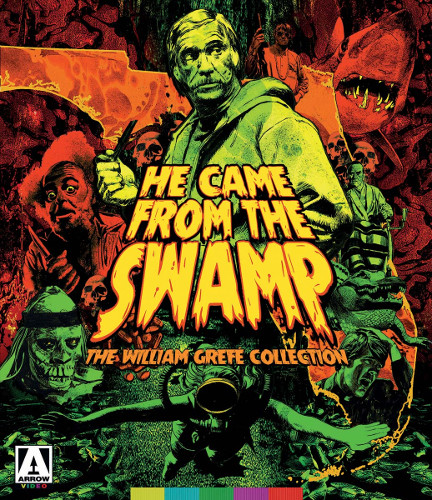
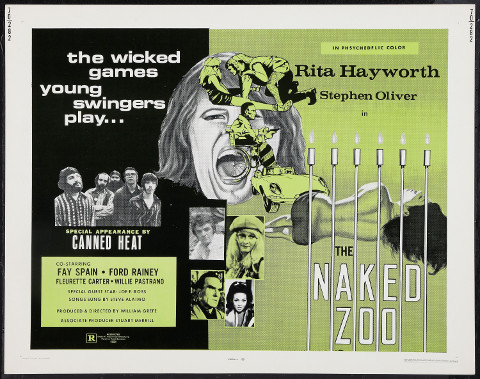

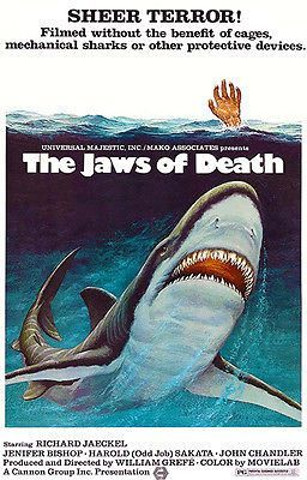
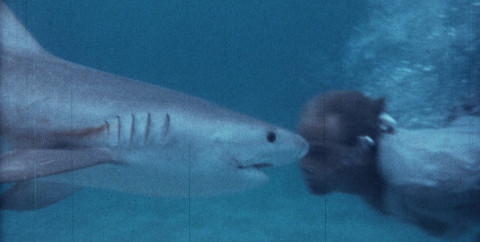
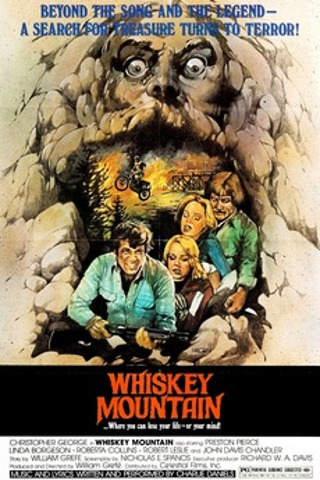
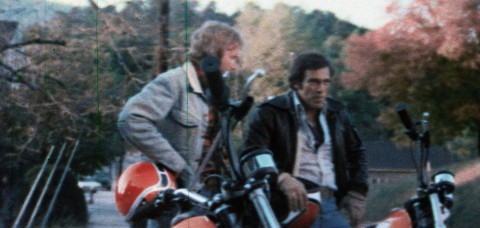

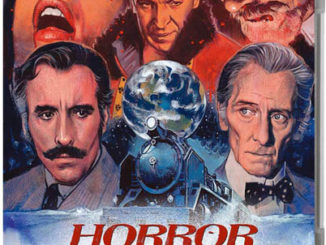

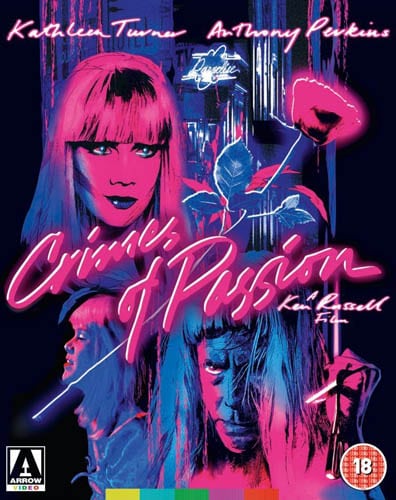
Be the first to comment